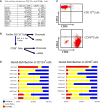Chromatin signatures in multipotent human hematopoietic stem cells indicate the fate of bivalent genes during differentiation
- PMID: 19128795
- PMCID: PMC2785912
- DOI: 10.1016/j.stem.2008.11.011
Chromatin signatures in multipotent human hematopoietic stem cells indicate the fate of bivalent genes during differentiation
Abstract
Histone modifications have been implicated in stem cell maintenance and differentiation. We have analyzed genome-wide changes in gene expression and histone modifications during differentiation of multipotent human primary hematopoietic stem cells/progenitor cells (HSCs/HPCs) into erythrocyte precursors. Our data indicate that H3K4me1, H3K9me1, and H3K27me1 associate with enhancers of differentiation genes prior to their activation and correlate with basal expression, suggesting that these monomethylations are involved in the maintenance of activation potential required for differentiation. In addition, although the majority of genes associated with both H3K4me3 and H3K27me3 in HSCs/HPCs become silent and lose H3K4me3 after differentiation, those that lose H3K27me3 and become activated after differentiation are associated with increased levels of H2A.Z, H3K4me1, H3K9me1, H4K20me1, and RNA polymerase II in HSCs/HPCs. Thus, our data suggest that gene expression changes during differentiation are programmed by chromatin modifications present at the HSC/HPC stage and provide a resource for enhancer and promoter identification.
Figures








Comment in
-
Glimpses of the epigenetic landscape.Cell Stem Cell. 2009 Jan 9;4(1):1-2. doi: 10.1016/j.stem.2008.12.006. Cell Stem Cell. 2009. PMID: 19128786
References
-
- Ansel KM, Djuretic I, Tanasa B, Rao A. Regulation of Th2 differentiation and Il4 locus accessibility. Annu Rev Immunol. 2006;24:607–656. - PubMed
-
- Azuara V, Perry P, Sauer S, Spivakov M, Jorgensen HF, John RM, Gouti M, Casanova M, Warnes G, Merkenschlager M, Fisher AG. Chromatin signatures of pluripotent cell lines. Nat Cell Biol. 2006;8:532–538. - PubMed
-
- Barski A, Cuddapah S, Cui K, Roh TY, Schones DE, Wang Z, Wei G, Chepelev I, Zhao K. High-resolution profiling of histone methylations in the human genome. Cell. 2007;129:823–837. - PubMed
-
- Bernstein BE, Kamal M, Lindblad-Toh K, Bekiranov S, Bailey DK, Huebert DJ, McMahon S, Karlsson EK, Kulbokas EJ, 3rd, Gingeras TR, et al. Genomic maps and comparative analysis of histone modifications in human and mouse. Cell. 2005;120:169–181. - PubMed
-
- Bernstein BE, Mikkelsen TS, Xie X, Kamal M, Huebert DJ, Cuff J, Fry B, Meissner A, Wernig M, Plath K, et al. A bivalent chromatin structure marks key developmental genes in embryonic stem cells. Cell. 2006;125:315–326. - PubMed
Publication types
MeSH terms
Substances
Grants and funding
LinkOut - more resources
Full Text Sources
Other Literature Sources
Medical
Molecular Biology Databases

